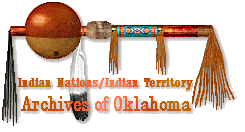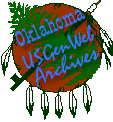Woodward County
Woodward County
County Seat -
Woodward
 Home |
Archives |
Cemeteries |
History |
Obits
|
Look-ups | Queries
| Resources
Home |
Archives |
Cemeteries |
History |
Obits
|
Look-ups | Queries
| Resources
"Links to web sites that are not part of the USGenWeb Project are provided for
your convenience and do not imply any endorsement of the web sites or their
contents by The USGenWeb
Project."
State's Deadliest Tornado Struck 50 Years Ago
04/06/1997 By Ann DeFrange Staff Writer - The Daily Oklahoman
More information at
1947 Tornado
Some Post Card Photos of the
Tornado
''If you're in the newspaper business,'' Chan Guffey said, ''you know to call the
newspaper.'' So on the night 50 years ago when the gigantic tornado made rubble of the
small town where he edited the daily newspaper, he took double advantage of the one phone
call he got to make. ''I called The Daily Oklahoman'' in Oklahoma City, he recalled. He
filed the first news report of the deadly storm that had hit Woodward in the past few
hours, and he requested that medical assistance personnel be dispatched to western
Oklahoma.
The tragedy that tops the National Weather Service's list of the most deadly tornadoes
in Oklahoma history came to Woodward on April 9, 1947. The storm that nourished it formed
in the Pacific Ocean several days earlier, then blew its way across California and Utah
and into the Texas Panhandle. In Texas, a low pressure area moved enticingly near a cold
front in Kansas. Around Amarillo, as the turbulence geared up to 200 mph, funnels began to
shape until five or six twisters dipped out of the clouds. The one that forced its way
into Oklahoma traveled along the ground for about six hours, observers estimated, long
enough to mow a path about 200 miles long. Shortly before 9 p.m. on that Wednesday night,
it slammed into the west edge of Woodward. It destroyed or damaged the courthouse, the
hospital, the school, structures on 36 city blocks ... and 116 lives.
Channing Guffey had arrived in Woodward, population 5,500, from Kansas six months
earlier. ''I wasn't a newspaperman,'' he said. ''I was learning to be one.'' But he was
''editor and staff'' of the Woodward Daily Press, assisted only by one of the owners, who
wrote the society column. So far, the biggest story he had written for the Daily Press, in
his opinion, was a notice of his marriage to a Woodward schoolteacher. He and his new
wife, Hope, lived in a one-room apartment remodeled with glass windows from an upstairs
porch. Guffey recalled the evening: ''Out there, the wind blows pretty good anytime. But
the wind came up really good.'' The windows on the west side rattled, then on the north,
then the east ... ''in sequence, almost.'' By the time the couple reached the bottom of
their outdoor staircase, ''debris ... hit the garage like 5-inch cannons.'' And everything
stopped, including electricity and telephone service. They stretched out flat along the
foundation of the house. When the wind eased and Guffey started up the stairs to find his
clothes, the stairway dangled, and in the pitch black, stars were visible where the roof
had been. He found a pair of pants wrapped around a light fixture. He filled his bathtub
with the last bit of water pressure left in his plumbing and washed off the lime from
broken buildings. ''I suspect I was the last person to get a bath in Woodward for two
days,'' he said. He located town officials, who were meeting by candlelight and divided on
action. In the dark, the extent of the damage was invisible. ''Some wanted to call for
help; some wanted to handle it themselves.'' Guffey borrowed a car for a wind-buffeted
drive to Seiling, about 35 miles to the east. He waited for a highway patrol trooper to
call his headquarters from the telephone office. By midnight, medical personnel from
hundreds of miles away were on their way with plasma, generators and blankets. Highway
patrolmen en route to Woodward stopped at each small town and requested ambulances. The
Salvation Army and Red Cross arrived. Guffey provided enough information to The Oklahoman
that ''they got some kind of information in the first edition that night.'' His own paper,
the Daily Press, did not publish for four or five days, he said. Sand had blown in through
a broken window and clogged the Linotype machine. Guffey made an editorial decision that
the story was old news by then. His tornado report ran across the bottom of the front
page.
It was days before the dead and injured were counted and the weather service was able
to classify the tornado as the awful champion it was. No one really was sure about the
figures. Always, deep in the collective memory of Woodward, would remain the fact that at
least three unidentified children were buried without names and at least one 4-year-old
girl disappeared from her family; it was assumed that someone ''stole'' her from the
hospital. But finally, it was determined that the tornado killed about 200 people along
its path from Texas. Of those, 116 lived and died in Woodward. More than 700 were injured.
Three thousand people had no homes. When the science became more sophisticated years
later, it was determined the Woodward tornado was an F-5 level, one of the most violent.
Guffey was one of the homeless, so after he and his wife lived in a basement for a few
months, he began job hunting. From 1947 until 1961, he worked for The Oklahoman and the
Oklahoma City Times, becoming city editor of The Oklahoman before he left. For the next 24
years, he published a real estate business paper, Guffey's Journal.
Newspaper reporter Richard Bedard wasn't born until 15 years after the Woodward
tornado, and he didn't see firsthand one of those marvels of nature until he was past 30
years old. But whereas Guffey had to drive to a telephone to report the aftermath of a
tornado, Bedard is part of the Nexrad generation, which has applied awesome meteorological
technology to its pursuit of the devastating wind. Bedard's fascination with tornadoes
goes back to the age when all little boys have ''black, dark dreams.'' Where he grew up in
Maine, little-boy nightmares had more to do with bears and scary monsters than the ''big,
black, whirling thing that swept in from nowhere'' and visited him in his sleep. ''We
didn't have tornadoes up in Maine,'' he said. But rather than terror, he developed a
fascination with the phenomenon indigenous to the Midwest. When he tried to research it in
his local library, he found ''no good, general, nonfiction book'' about tornadoes. He
decided to write one. He chose to quit his job, leave his home and move to Oklahoma.
Norman seemed the place to be, he said. The National Severe Storms Laboratory is there.
Frequency graphs verify that Oklahoma's midsection along the fabled Tornado Alley ''almost
has a bulls-eye on it.'' And Bedard quotes old-time gangster Willie Sutton, who said he
robbed banks because ''that's where the money is.'' Bedard said, ''I thought I was going
to move here and spend about a year writing the book. ... I would just wait until a large
tornado happened to strike that season, and go to the town and live there. ''But then, I
found there was this really large tornado no one had ever written about.'' Other than
local histories and significant anniversaries, the 1947 tragedy had been largely
undocumented. The mysteries of the unidentified children and the stolen girl intrigued and
plagued Woodward but remained unsolved. ''How could that be?'' Bedard wondered. ''No one
stepped forward to claim them. To me, it was a sign of the tremendous chaos, confusion,
bedlam.'' For two weeks in 1993, from a Woodward motel room, he sought out and interviewed
residents who survived the tornado, and they would send him others, and they would
recommend more. ''Some memories were extremely sharp, as if the event had occurred the
week before,'' he said. But ''memories deteriorate ... days merge.'' When he tried to
reconstruct the weather of that day, he heard it was sunny, or overcast, or windy, or
calm. But he pieced together the facts and filled in the feelings. A woman who related
''with little emotion and graphic detail'' the destruction of her home near Gage became
emotional over an anecdote about her daughter's doll cradle flying into a field. ''I know
she was thinking her children could have been there.'' Bedard, the outsider, has noted
that aerial observation still shows the tornado's path, that a tree beside the courthouse
still leans in the direction of the tornado's wind, that if certain yards were excavated
throughout Woodward, artifacts of pre-tornado homes and lives would be found a few inches
down. Other signs he discovered were more subtle. ''A woman ... told me that her husband,
who lived through the tornado, gets goose bumps when a storm comes.'' Storm cellars are
common in the rebuilt neighborhoods, and Bedard perceives that Woodward is perhaps ''more
responsive and appreciative of televised warnings.'' He said, ''When you live through
something of those epic proportions, it does change your outlook. It makes you probably a
little more jumpy and restless when spring severe weather comes through. ''But there's
something to be said about deriving a certain strength of character from life's darkest
moment.'' Bedard's self-published book, ''In the Shadow of the Tornado,'' is selling well
at Oklahoma bookstores and has received an award from professional meteorologists. And he
still is in Norman, ''selling books and sniffing out storms,'' because ''in the meantime,
I guess I caught the storm bug.'' It's April again. He has hooked up with a group of storm
chasers, and there are potential books for a writer like himself on the storm-chaser
sub-culture or the storm lab itself. And in Woodward, he's heard a tale about a tornado
that knocked down a man's house, but the man bought lumber and rebuilt the house, and a
tornado demolished it again, and the man rebuilt it again. That is the kind of people he
didn't expect when he read about the West, Bedard said. But that's the kind he's found.
''They're there, and it's their home, and they're going to stay.'' No matter how many
tornadoes came at them, he's decided, those Oklahomans ''would have come back.''
Deadliest Tornadoes
|
April 9, 1947 |
116 killed |
Woodward |
|
May 10, 1905 |
97 killed |
Snyder |
|
May 2, 1920 |
71 killed |
Peggs |
|
April 12, 1945 |
69 killed |
Antlers |
|
April 27, 1942 |
52 killed |
Pryor |
|
June 12, 1942 |
35 killed |
Okla. City |
|
April 25, 1893 |
33 killed |
Norman |
|
Nov. 19, 1930 |
23 killed |
Bethany |
|
May 8, 1882 |
21 killed |
McAlester |
|
May 25, 1955 |
20 killed |
Blackwell |
| |
|
|
National Weather Service
This page was last updated on
01/09/11
Woodward Co

God Bless America
Hosted & © 2025 by:

OKGenWeb State Coordinator
Linda Simpson
Asst: Mel Owings
© 1996-Present ~ All Rights Reserved
| USGenWeb NOTICE: In keeping with our policy of providing free Information on the Internet, data may be used by non-commercial entities, as long as this message remains on all copied material. These electronic pages may NOT be reproduced in any format for profit or for presentation by other persons or organizations. Files may be printed or copied for Personal use only. Persons or organizations desiring to use this material for purposes other than stated above must obtain the written consent of the file contributor. |

 Home |
Archives |
Cemeteries |
History |
Obits
|
Look-ups | Queries
| Resources
Home |
Archives |
Cemeteries |
History |
Obits
|
Look-ups | Queries
| Resources





